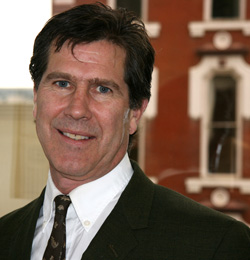Correction: This post has been updated to reflect Raleigh’s geographic area as 142 square miles.
Since 1986, Raleigh’s population has grown by more than 220 percent, and the city itself has grown from 80 acres to about 142 square miles. Raleigh has grown out, adding suburbs upon suburbs, pushing the city toward the county line in every direction. In recent years, Raleigh is struggling with growing pains, adding density and abuzz with phrases like “urban form.”

City of Raleigh
Greg Hallam. Photo by City of Raleigh.
Greg Hallam worked with the city through this change. He started working with Raleigh’s planning department Sept. 8, 1986. His retirement began last week. Hallam has, in his words, “been in the trenches” these last 26 years—rezoning properties, writing new laws, navigating the politics and, at times, the heated emotions of change in a growing city.
Hallam is one of the people who actually took those applications to put up a big building in your backyard or create a new subdivision. His job has been to make sure it complies with the city’s land use laws and shuffle the project through what he calls an increasingly politicized process. He’s seen a lot of change in the process and in the way city government works.
In the most practical ways, Hallam said when he started, “you could smoke at your desk.” Then smokers were moved to the snack room, then the stairwells, and finally outside. One of the biggest changes, Hallam said, was getting rid of the snack bar in City Hall. That used to be the place to get work done in a more informal way, and people from across departments could get involved in the conversations.
“Now, there’s no face-to-face conversation. It’s all over email now, not even talking to each other on the phone,” Hallam said. “It’s almost anonymous.”
The new dynamic of doing city business by email has made the city’s departments, in Hallam’s words, “more territorial.” He said, “There used to be a lot more compromise” between departments and on zoning cases.
The re-zoning process itself has gone though a lot of change. Hallam points to when the city started broadcasting the Planning Commission and City Council meetings on public television. He said the meetings became a soapbox.
Hallam said Councilors and Commission members began to “belittle staff to win favor with their constituents.” He wouldn’t point to specific examples, but he said members of the planning staff would catch flak from all sides.
“I never used to find myself in the middle,” he said.
While presenting new projects in public meetings, Hallam said he and other people on the front lines of the Planning Department would find themselves in the midst of heated arguments.
“People would want to know: who are you with? Are you with the neighborhood side or the development side?”
Hallam said another major change he’s experienced has been with the makeup of the Planning Commission, a public body set up to review new building projects and re-zoning requests. The Commission members are appointed by members of the City Council.
“Planning Commission appointees are more and more moving from a citizen board to one in the development field,” he said.
He pointed to some members who have day jobs in the development industry or land use attorneys.
“People in development see it as a way to advance their careers,” he said.
Life Beyond Retirement
What do you do after 26 years in municipal zoning? Just because he’s retiring from the city doesn’t mean Hallam plans to stop working. Hallam recently finished bartending school (he had a coupon) and he’s already picking up shifts behind the bar at PieBird on Person Street. And he’s recently been accepted to Wake Tech’s culinary program.
PieBird is a short work from Hallam’s home in the Oakwood neighborhood. The restaurant specializes in, as the name implies, pie. But it’s also one of the few bars within reasonable walking distance of his neighborhood.
PieBird has never really had a dedicated bartender. Hallam hopes his new found time and his new certificate in bartending can help fix that, and give a place for neighbors around Person Street to come together, meet each other and create more community in the area.
Learning from his decades in city planning, Hallam said, “A neighborhood bar is a vital function for happy lifestyles.”
